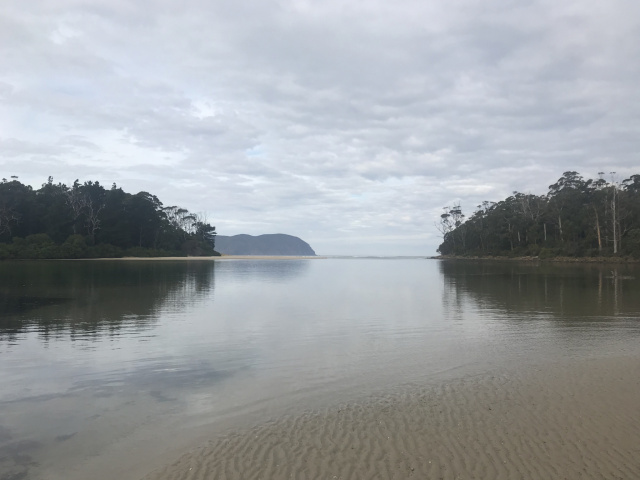Geological History of Bruny Island
Bruny Island
320 million years ago, when the supercontinent of Pangea was breaking up to form smaller supercontinents including Gondwana, southern Bruny Island lay below the ocean. Muddy sediments and sand deposited on the ocean floor gradually became rock, and between 280 and 220 million years ago this formed part of a broad freshwater plain that deposited sandy sediments on top of previous layers.
Over time these layers of sediment became the sandstone of today.
Then 174 million years ago, huge volumes of magma rose from deep inside the Earth's crust, then hardening to form the dolerite that dominates the Southern part of Bruny Island today and can be seen prominently in the dolerite cliffs of places like Fluted Cape.
This coincided with the breaking up of Gondwanaland and the formation of the continental formations of today.
At the end of the last ice age, sea levels rose to around their present levels 6,000 years ago, and in the process of the rising of sea levels, large volumes of sand were brought from the ocean floor and can be found in parts of Southern Bruny such as Cloudy Bay and the Labillardiere Peninsula.
Reference: Buckman, G. (2002, p.247-248). Tasmania's National Parks - A Visitor's Guide. Lindisfarne, Tasmania. Advance Publicity/Greg Buckman
Lead Photo: "Cliffs of Gold" by Warwick Berry.


320 million years ago, when the supercontinent of Pangea was breaking up to form smaller supercontinents including Gondwana, southern Bruny Island lay below the ocean. Muddy sediments and sand deposited on the ocean floor gradually became rock, and between 280 and 220 million years ago this formed part of a broad freshwater plain that deposited sandy sediments on top of previous layers.
Over time these layers of sediment became the sandstone of today.
Then 174 million years ago, huge volumes of magma rose from deep inside the Earth's crust, then hardening to form the dolerite that dominates the Southern part of Bruny Island today and can be seen prominently in the dolerite cliffs of places like Fluted Cape.
This coincided with the breaking up of Gondwanaland and the formation of the continental formations of today.
At the end of the last ice age, sea levels rose to around their present levels 6,000 years ago, and in the process of the rising of sea levels, large volumes of sand were brought from the ocean floor and can be found in parts of Southern Bruny such as Cloudy Bay and the Labillardiere Peninsula.
Reference: Buckman, G. (2002, p.247-248). Tasmania's National Parks - A Visitor's Guide. Lindisfarne, Tasmania. Advance Publicity/Greg Buckman
Lead Photo: "Cliffs of Gold" by Warwick Berry.


You might like...

Watch: behind the scenes at the Bruny Island Bird Festival
The Bruny Island Bird Festival celebrated its 7th festival in March this year. Held every two years, the biennial event is becoming ever-more popular, thanks to a dedicated and passionate cohort of bird ecologists, ornithologists, Nature lovers and the Bruny Island community. Join film-maker Marcio Conrado as he goes behind the scenes to capture the wonder.

Jamie Kirkpatrick - a giant of conservation
Vale Professor Jamie Kirkpatrick (1946 - 2024) Jamie was a giant of Tasmania's conservation movement, a World Heritage and National Parks expert and an internationally renowned geographer and conservation ecologist. He inspired countless hearts and minds, for Nature.

Growing up wild and healthy
For Friends of North Bruny Chair Simon Allston, his love of nature blossomed in his late teens, when his family moved to the bush and he was introduced to healthy eating and organic gardening. He has grown his own food ever since.

The incredible diversity of Bruny Island
Bruny Island is a really special place. It's got an incredible diversity of habitats. It's relatively undeveloped, relatively undamaged. So on Bruny Island you can see things like threatened species of birds, still breeding on this island, which is really a wonderful thing.
Newsletter
Sign up to keep in touch with articles, updates, events or news from Kuno, your platform for nature
